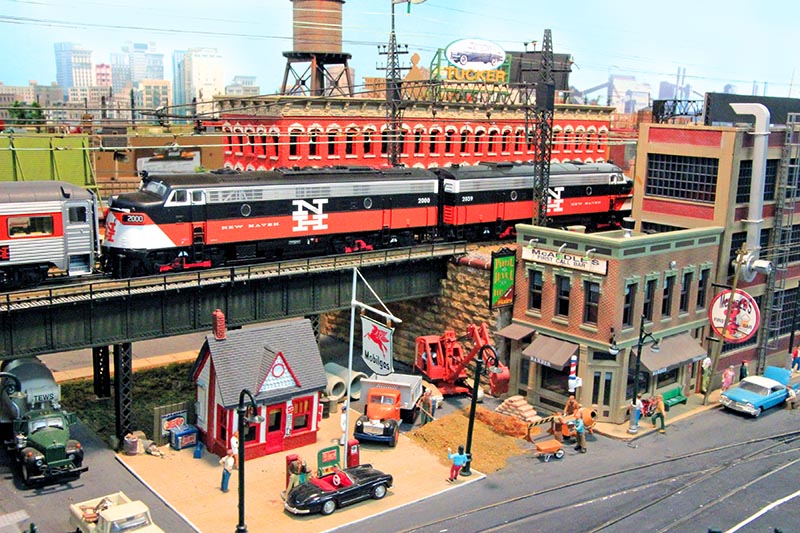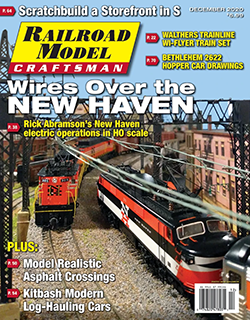 By Rick Abramson/photos by the author
By Rick Abramson/photos by the author
At the turn of the 20th century, the New York, New Haven & Hartford Railroad was a pioneer in the development and installation of the first high-voltage alternating current main line electrification in the United States. After a fatal rear-end collision in New York City’s Park Avenue Tunnel in 1902, where heavy smoke from steam locomotives obscured a red signal, the state legislature passed a law prohibiting the use of steam locomotives on Manhattan island after June 30, 1908. This led New York Central to electrify its lines running out of Grand Central Terminal through the Park Avenue Tunnel, choosing a 600-volt direct current third-rail system developed in part with General Electric.
Since the New Haven operated over NYC lines from Woodlawn Jct. to Grand Central Terminal, they would also need to develop their own plans for electrification. Direct current suffers from voltage loss over distance and requires substations to boost the power. Looking to electrify its main line all to way to New Haven, Conn., NH opted for a system utilizing 11,000 volt a.c. overhead catenary developed in conjunction with Westinghouse. To gain access to Grand Central, equipment would also have to be equipped to draw power from NYC’s 600-volt d.c. third rail.
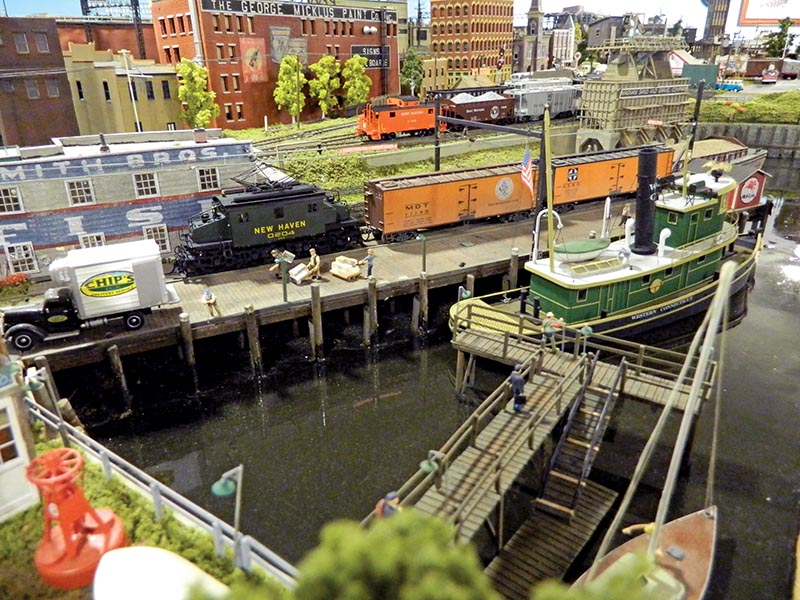
New Haven EY-2 0204 spots reefers on Belle Dock for Smith Bros. Fish Co. while the tug Susan A. is tied to the dock awaiting her next job. EY-2 by Overland, tug boat kit by Crow River Models.
The initial electrification was completed between Woodlawn Junction, N.Y., and Glenbrook, Conn., in 1907. With the success of this first segment, wires were extended east to Cedar Hill Yard in North Haven, Conn., and down the Harlem River Branch from New Rochelle, N.Y., to Oak Point Yard in the Bronx.
When Pennsylvania Railroad opened their tunnels under the Hudson and East rivers to reach New York City in 1910, a through connection to the New Haven was established with the opening of the Hell Gate Bridge in 1918. The Danbury Branch was electrified in 1925, while the freight branch to Bay Ridge, Brooklyn, was electrified in 1927, completing the extent of New Haven’s electric empire.
Like my father, I was always intrigued by the big electric locomotives (known simply as “motors”) with their piping, air tanks, heavily riveted carbodies, and some with their distinctive “porches.” Growing up deep in NH electric territory in Norwalk, Conn., I got to see the modern EP-5 “Jets” as well as the ex-Virginian EL-C “rectifiers” NH purchased from Norfolk & Western in 1963. Unfortunately, I never got to see any of the classic boxcabs or older streamlined motors which were condemned by anti-electric management in the 1950s.
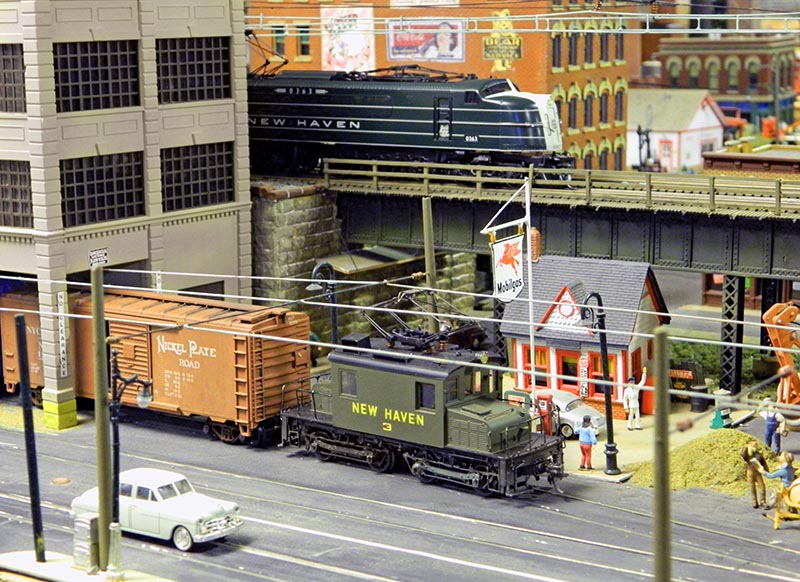
Up on the main line EP-4 0363 crosses a plate girder bridge over the teeming streets of Bridgeport, while below class EY-1 motor 3 switches out freight customers on Seaview Ave. The 600 volt d.c. trolley wire was removed in the early 1950s, when trolleys were replaced by diesel switchers.
Layout Design
Growing up as a traction fan alongside the New Haven main line, the die was cast early on. While some of my first layouts were traction-oriented, I hoped for the day when I would not only get to build my dream NH layout, but also work for the railroad. In February 1968 I got my wish when I hired on with the New Haven, the start of a 44-year railroad career. In April 1997 my hope for a true NH layout became reality.
The first order of business was to convert the unfinished basement area. Fellow NH modeler and builder-by-trade John Grosner installed all the studs, sheet rock and lighting. Now came the task of designing a track plan. Needless to say, the layout had to have a NH “flavor” which would naturally include NH-style overhead catenary and catenary bridges. After several design attempts, I decided in June 1997 to model the area where I worked on the NH in Devon, Conn.!
I knew I wanted to incorporate wide 36-38” radius curves where possible. Needless to say, selective compression always plays a major role in the designing of any track plan. I never believed in “stuffing 10 pounds of bologna into a one-pound bag.” With the space available, and knowing what I wanted to incorporate, a four-track main line at the front of the layout would be doable; it would then narrow down to two tracks towards the back and then reopen to the four tracks.
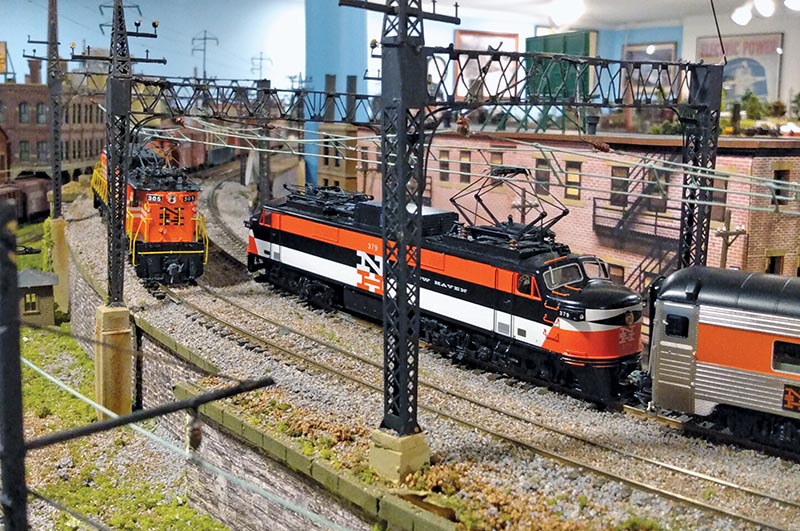
Action on famed Jenkins Curve in Bridgeport, Conn., as eastbound EF-4 Virginians meet a westbound express with a Jet. The location was named by railfans for its proximity to the Jenkins Valves factory.
I put together a list of what elements I wanted on the layout. The modeling era would cover the mid-1950s to December 1968 (the NH was ingloriously incorporated into the ill-fated Penn Central merger in 1969). I wanted origin and destination points which would eventually support future operating sessions. These locations would include Maybrook Yard (which was a major interchange for Eastern railroads) located near Poughkeepsie, N.Y.; Turkey Brook Yard in Derby, Conn., and East Bridgeport Yard. My Bridgeport harbor scene would feature a pier having a single track with catenary, otherwise known as the “Belle Dock Branch.”
Another aspect I wanted to include was NH’s Seaview Ave. Railroad in Bridgeport, which was primarily street-running, serving warehoues and factories utilizing class EY-1 switchers operating off 600-volt d.c. trolley wire (not a.c. catenary). Wanting to model this operation is what dictated a two-track representation of the famous four-track elevated main through this area…


